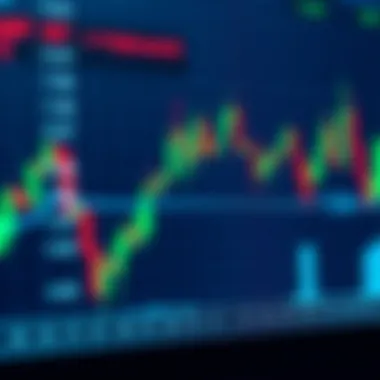Comprehensive Day Trade Analysis for Crypto Traders


Intro
Day trading in the world of cryptocurrencies is akin to riding a roller coaster—thrilling yet fraught with peril. For those eager to ride the waves of this fast-paced market, understanding its nuances is crucial. This article will unravel the complex tapestry of day trading strategies, while shining a light on market indicators, psychological factors, and astute risk management. As the crypto landscape continues to evolve faster than one could blink, our journey through this guide aims to empower traders with knowledge and insight.
Market Trends and Analysis
Current Market Overview
As of late 2023, the cryptocurrency market portrays a landscape that is both dynamic and unpredictable. Prices can swing wildly in mere moments. What drives this volatility? Factors such as regulatory changes, technological advancements, and investor sentiment play vital roles.
For instance, if a significant country announces a new regulatory framework for digital currencies, we often see a ripple effect that can dramatically impact the market prices. It’s critical for traders to stay informed about these trends, as they serve as indicators of potential price movements.
Additionally, tracking market capitalization, trading volume, and liquidity can provide insights into the market's current health. Volatility is a double-edged sword—it can lead to swift profits, but it can also incite staggering losses if one isn’t adequately prepared.
Influential Market Factors
Understanding the various factors that influence crypto markets can be the difference between profit and loss. Here's a concise breakdown:
- Regulatory News: Developments in laws can send ripples through the market and should be monitored closely.
- Technological Changes: Innovations or upgrades to blockchain technology can inspire trading frenzies.
- Market Sentiment: Social media platforms and forums like Reddit can stir emotional trading patterns that may not align with market fundamentals.
Moreover, economic indicators, like inflation rates and macroeconomic trends, can provide context for price movements. Thus, developing a keen eye for these elements is a vital skill for any day trader.
"In trading and investing, it helps to be a bit of a detective—putting together clues to make sense of the trends."
Blockchain Technology Insights
Technical Innovations
Blockchain technology is the backbone of all cryptocurrencies and its innovations never cease to astound. From smart contracts to decentralized finance (DeFi) protocols, new developments influence how traders approach the market.
For example, Ethereum's transition to a proof-of-stake model is changing the playing field. This shift not only improves scalability but may also impact how traders consider the value of Ether in their day trading strategies.


Use Cases in Various Industries
Beyond trading, blockchain has a myriad of applications that reflect its potential to disrupt traditional systems. Consider the financial sector: many banks now explore blockchain for transaction security and efficiency. Similarly, industries such as supply chain management and healthcare are leveraging this technology to enhance transparency.
Traders should keep track of such developments. For instance, if a major company decides to adopt blockchain technology for its operations, it may positively influence the cryptocurrency associated with that technology.
Final Thoughts
As the crypto market continues its unpredictable waltz, understanding these components will enable traders to sharpen their strategies. Keeping an eye on market trends and the underlying technology can offer clues that inform better trading decisions. This ongoing practice not only enhances one’s ability to navigate through volatility but ultimately leads to more informed and calculated trading endeavors.
By synthesizing market analysis with insights into technological developments, traders can arm themselves with the necessary tools to thrive in a competitive landscape.
Prelims to Day Trading
Day trading emerges as one of the most dynamic facets of the financial markets, particularly in the fast-evolving world of cryptocurrencies. Its significance lies in allowing traders to capitalize on small price movements within a single trading day. Unlike traditional investing, where positions might be held for weeks, months, or even years, day trading demands a unique skill set, temperament, and a keen understanding of market mechanics.
The essence of day trading is not merely about buying low and selling high, but understanding and navigating the complexities of market volatility. Being able to interpret charts, assess risks, and manage one's emotional responses are critical components of successful day trading. With the rise of digital currencies such as Bitcoin and Ethereum, day trading has become more accessible but also more competitive. This article aims to straightforwardly break down what day trading entails and explore the essential frameworks that underpin effective strategies.
Defining Day Trading
Day trading, at its core, involves the practice of buying and selling financial instruments within the same trading day. Traders end up closing out their positions before the market closes, preventing overnight exposure to potential adverse market movements. In the world of cryptocurrencies, this practice is particularly relevant, as the market is open 24/7, offering endless opportunities for those with the necessary skills.
A key aspect of day trading includes the use of various strategies such as scalping and momentum trading. Scalpers aim to make numerous small trades, capitalizing on tiny price movements. In contrast, momentum traders seek to benefit from trends by riding the wave of price movements, usually entering into trades that align with the prevailing market force. The adrenaline rush of executing trades throughout the day keeps many engaged, yet it is essential to remember that not all day trading is profitable.
Understanding the fine line between success and failure in this arena often comes down to one’s analytical skills and emotional control. It’s this blend of technique and psychology that separates effective day traders from those who falter.
Historical Context in Financial Markets
To fully grasp the concept of day trading, it is valuable to delve into its historical context within financial markets. Traditionally, day trading can be traced back to the stock market, where it gained popularity in the late 20th century with the advent of electronic trading platforms. In those early days, it was generally viewed as a pursuit for wealthy individuals who could afford the high transaction costs and had direct access to stock exchange floors.
The introduction of the internet revolutionized this format, democratizing access to financial markets. Retail investors began to emerge, empowered by online trading platforms that provided them with the tools and resources necessary for active trading.
As the financial landscape evolved, so too did the strategies employed by traders. The rise of algorithmic trading in the early 21st century changed the game, enabling rapid trading operations driven by complex algorithms. This shift not only influenced more traditional markets but paved the way for day trading within the cryptocurrency realm that we observe today.


Now, just a click away, anyone with an internet connection can partake in day trading. However, proper understanding of its intricacies and market behaviors remains vital. Today’s market dynamics are shaped by technological advancements, behavioral finance, and various socio-economic factors, all of which must be considered by aspiring day traders as they embark on their trading journey.
Fundamentals of Day Trading
Understanding the fundamentals of day trading is crucial for anyone looking to navigate the bustling world of cryptocurrency trading. These fundamentals provide a sturdy framework that can guide traders through the choppy waters of rapid market changes. By delving into principles and market dynamics, traders come equipped with insights that can enhance their decision-making abilities, minimize losses, and maximize gains. This section will dissect what elements make up day trading's backbone, the benefits of mastering these basics, and what considerations one should have in mind.
Key Principles
The foundation of day trading consists of several key principles that traders must grasp if they wish to be effective. Here are some pivotal elements:
- Timeframe Mastery: Day traders often work within tight timeframes, executing trades within the span of a single day. This necessitates a keen understanding of charts and patterns, where recognizing trends quickly can make or break a trade.
- Liquidity Awareness: In the crypto space, liquidity refers to how easily an asset can be bought or sold without causing a significant impact on its price. A trader should aim for assets that are liquid—meaning there are enough buyers and sellers to facilitate smooth transactions.
- Market Orders vs. Limit Orders: Knowing when to use market orders—executing trades instantly at current market prices—versus limit orders, which allow traders to specify the price at which they are willing to buy or sell, is essential for managing entry and exit strategies effectively.
- Mindset and Discipline: A strong focus and mental clarity are essential. Traders often encounter scenarios that test their emotional fortitude. The ability to stick to a crafted strategy and resist impulsive decisions significantly enhance the chances of success.
Mastering these principles can empower traders to approach their activities with confidence, minimizing hesitations that lead to missed opportunities or avoidable losses.
Market Dynamics
Beyond mastering the core principles, a trader must also attune themselves to the underlying dynamics of the market. A few key aspects include:
- Understanding Market Sentiment: Recognizing whether the market is bullish (growing) or bearish (declining) can shape trading strategies. Traders need to keep an eye on news events or developments in the crypto space, as they can rapidly shift market sentiment and consequently affect prices.
- Technical Indicators: These are mathematical calculations based on historical price, volume, or open interest in a security or contract. Familiarizing oneself with tools like Moving Averages, Relative Strength Index (RSI), and Bollinger Bands can provide pivotal insights into market trends.
- Volume Trends: The volume of trades can indicate the strength of a price movement. High volume often corresponds with significant price shifts, while lower volume may suggest indecision in the market. Understanding this can lead to more informed trading decisions.
- External Influences: The world of cryptocurrency is subject to fluctuations based on broader economic indicators and geopolitical events. Global news—be it regulatory announcements, major company transitions, or security breaches—can greatly influence market dynamics.
By tuning into these market dynamics, traders can better predict potential movements and align their strategies accordingly.
"In the fast-paced environment of day trading, knowing the rules of the game is half the battle. Adapting to the constantly shifting landscape is where the true mastery lies."
Diving deep into the fundamentals equips day traders not just with knowledge, but with the tools and strategies to thrive in an increasingly competitive space. Recognizing the importance of timeframes, liquidity, and understanding both market sentiment and technical indicators lays the groundwork for a sustainable trading practice.
Analyzing Market Conditions
When it comes to the art of day trading, the ability to analyze market conditions isn't just an optional skill; it’s fundamentally integral to success. Understanding market dynamics—what makes it tick and pulse—is the bedrock upon which good trading decisions are built. By effectively analyzing these conditions, traders can identify trends, potential entry and exit points, and even the inevitable market corrections that arise with such regularity. This section drills down into two core components: Technical Analysis Tools and Fundamental Analysis.
Technical Analysis Tools
Technical analysis tools are vital for any day trader looking to decipher market movements. By leveraging various indicators, traders can sift through the noise and focus on price action. Key tools include:


- Moving Averages: Smooth out price data by creating a constantly updated average price. Traders often use the 50-day and 200-day moving averages to identify potential support and resistance levels.
- Relative Strength Index (RSI): This momentum oscillator measures the speed and change of price movements, helping to identify overbought or oversold conditions in the market.
- Bollinger Bands: These bands use standard deviations and a moving average to illustrate volatility. A price that touches or crosses the upper band may suggest a security is overbought, while a price that touches the lower band may suggest it is oversold.
- Volume Indicators: Monitoring trading volume can offer insights into market strength. High volume during a price movement can indicate its sustainability.
Utilizing these tools not only refines a trader’s ability to spot opportunities, but also helps in managing potential trades effectively. However, no tool or indicator is foolproof. They work best when used in conjunction with one another, ensuring a multi-faceted analysis.
"In day trading, data leads the charge, but refined interpretation seals the deal."
Fundamental Analysis
While technical indicators help inform traders about market movements, fundamental analysis digs deeper into the core of what drives those movements. For crypto enthusiasts, fundamental factors are particularly crucial. This form of analysis involves examining various elements such as:
- Market Sentiment: Gauge the collective excitement, fear, or uncertainty among investors. Tools like sentiment analysis platforms or social media monitoring can provide valuable insights on public perception.
- Regulatory Developments: Changes in laws can significantly impact cryptocurrency valuations. Tools like news aggregators can help traders stay updated with real-time changes that may affect their trades.
- Economic Indicators: Issues such as inflation rates, interest rates, and other macroeconomic indicators can influence investor behavior and, consequently, market conditions.
- News and Events: Major announcements or events (like hacks, ICO launches, etc.) can trigger volatility. Keeping tabs on reliable news sources can be crucial.
Combining fundamental analysis with technical tools provides traders not only a clearer picture of current conditions but also a more robust framework for making informed trading decisions. By analyzing multiple facets of the market, traders can mitigate risks while maximizing the potential for successful trades.
In summary, whether it be through adopting technical indicators or analyzing fundamental aspects, assessing market conditions is an essential component for any trader. Mastering this dual approach paves the way towards building competency and confidence in decision-making, transforming traders from novices into educated market players.
Risk Management in Day Trading
Risk management stands as a cornerstone in the realm of day trading, particularly within the fast-paced environment of cryptocurrency. Trading in this domain can be as unpredictable as the weather in spring; one moment the market is sunny, and the next, a storm rolls in, leaving trades in disarray. Understanding how to manage risk is pivotal, and it often dictates the difference between success and continual financial loss. With appropriate risk management strategies, traders not only protect themselves from significant losses but also enhance their overall trading performance.
One key benefit of robust risk management is its ability to offer traders a systematic method to handle the unavoidable volatility of crypto markets. The crypto landscape is rife with uncertainties, with prices swinging wildly based on market sentiment, news, and regulatory changes. Therefore, establishing a solid risk management framework is an actionable way to minimize the impact of these swings on one's investment portfolio.
Establishing Risk Parameters
Establishing clear risk parameters is analogous to setting the boundaries of your trading arena. This entails defining how much of your capital you are willing to risk on any given trade. A prudent rule of thumb commonly advocated among seasoned traders is to risk no more than one to two percent of your total trading account on a single trade. By doing so, even a streak of losses won’t completely deplete your funds and will give you the breathing space to regroup and refine strategies.
Additionally, traders should identify stop-loss and take-profit levels. These are predetermined points at which you either accept a loss or lock in gains. Setting these levels is not just a tactical move; it's also a psychological cushion. Accepting losses upfront allows traders to trade without the emotional rollercoaster that can accompany losses.
"Proper risk management can mean the difference between a stormy trading journey and clear skies ahead."
Position Sizing
Position sizing revolves around determining how many units of a particular asset you should buy or sell, taking into account the risk per trade previously established. It seeks to find the equilibrium between risk and reward, ensuring that no single trade can cause unbearable damage to your overall capital.
This process can require some detailed calculations, especially when dealing with volatile assets. To illustrate, consider a hypothetical situation where you have a trading account of $10,000 and you decide to risk 1% per trade. In this case, your risk per trade equals $100. If a certain crypto coin is priced at $50, you would determine the number of shares you could purchase by calculating:
plaintext Number of units = Risk per trade / (Entry price - Stop loss price)



